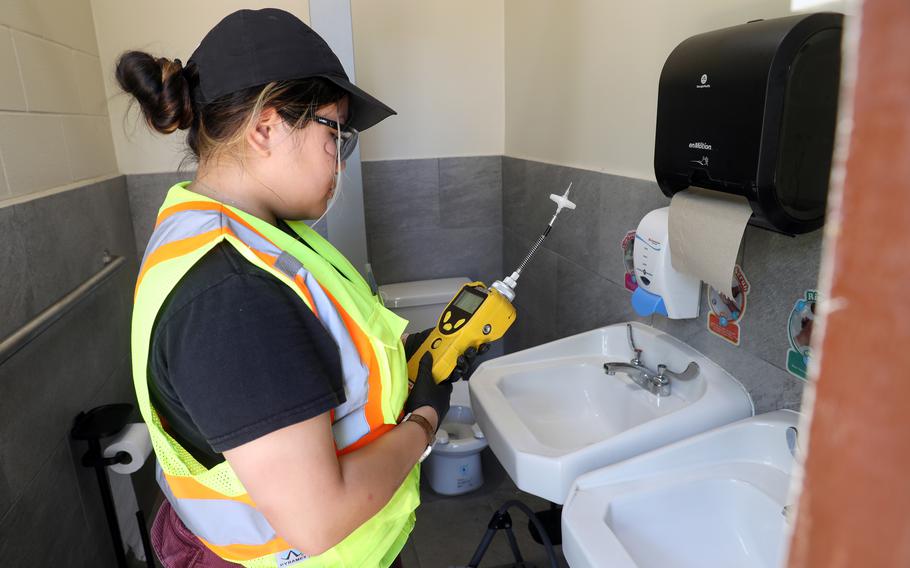
A Navy contractor collects a drinking water sample at Moanalua Preschool in Honolulu on Feb. 27, 2024. (Glenn Slaughter/U.S. Navy)
FORT SHAFTER, Hawaii — The Defense Department’s complex management of the defunct Red Hill underground fuel storage facility in Honolulu relied on contractors for essential services in the years preceding disastrous fuel leaks in 2021, according to a government watchdog.
“DOD used a decentralized structure that, in part, relied on a complex and interconnected set of roles and responsibilities to manage the operations, maintenance, and repair activities at Red Hill,” the U.S. Government Accountability Office said in a report Monday.
“Prior to the 2021 leaks, contractors also played an essential role in the maintenance and repair of equipment,” it said.
The GAO report offers no conclusions about the degree to which contractors might have contributed to the fuel leaks.
The review, however, was sparked in part by the role a contractor played in a November 2022 spill of a concentrated form of a hazardous fire-fighting foam at the facility.
About 1,300 gallons of foam escaped into the environment because a contractor improperly installed a valve on the system that allowed the release, a DOD investigation concluded.
“Both the fuel leaks and the [foam] concentrate release have raised questions about what role, if any, that contractors had in the operations, maintenance, and repair of Red Hill and the Navy’s oversight of its contractors,” the GAO report states.
The GAO review was requested by Sen. Mazie Hirono, D-Hawaii, chair of the Senate Armed Services Committee’s subcommittee on readiness.
Jet fuel leaks in May and November 2021 contaminated the Navy’s water distribution system that supplied military communities on and near Joint Base Pearl Harbor-Hickam. The contamination forced thousands to temporarily relocate to area hotels as the Navy flushed the system and isolated the tainted well.
Defense Secretary Lloyd Austin announced in March 2022 that the World War II-era facility would be permanently closed. The Navy is amid a multiyear effort to clean the 20 massive tanks and clean up contamination in the area surrounding them.
A Navy investigation into the cause of the fuel leaks concluded that several deficiencies had led to the spill, including poor training and ineffective command and control.
Several DOD entities had a hand in the Red Hill operation in 2021, including Navy Region Hawaii, the Defense Logistics Agency, Navy Supply Systems Command, Fleet Logistics Center Pearl Harbor, Naval Facilities Engineering Systems Command and the Army Corps of Engineers, the GAO report states.
At the time of the leaks, the Navy managed Red Hill operations, maintenance and repair activities with support from the Defense Logistics Agency, which owned the fuel in the tanks.
“The decentralized structure at Red Hill necessitated careful coordination, communication, and management of responsibilities and relationships,” the report states.
For example, the logistics agency was not involved in day-to-day operations unless fuel was being delivered, at which time they coordinated with Fleet Logistics Center Pearl Harbor.
And although the logistics center was responsible for operating the facility, it had no role in larger maintenance or repair of the tanks or facility.
Contractors performed key roles in maintaining and repairing equipment at Red Hill in the years leading up to the 2021 leaks, according to the report.
“Contractors were responsible for performing preventative maintenance and corrective repairs on the fuel tanks, pipelines, supporting equipment and systems, as well as monitoring services,” the report states.
The Navy, however, changed its approach to contracting for Red Hill after the contamination. It awarded eight of the 10 pre-spill contracts reviewed by GAO on a competitive basis.
“After the 2021 fuel leaks, the Navy awarded all six of the contracts GAO reviewed noncompetitively, in part to address urgent safety or environmental concerns, improve facility operations, and identify needed maintenance and repairs,” the report states.